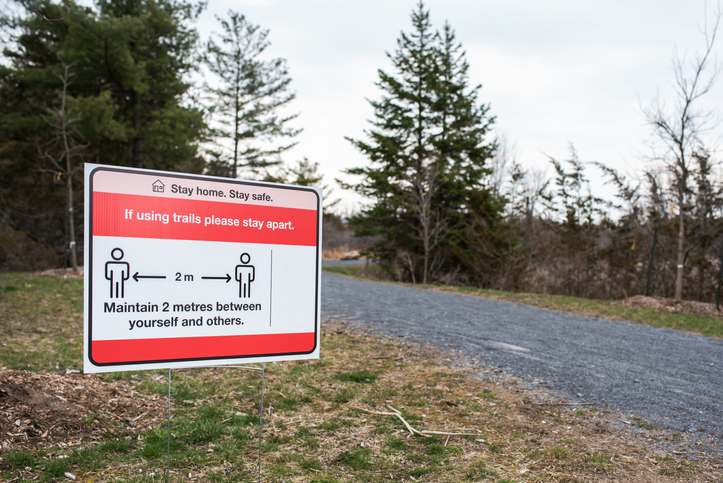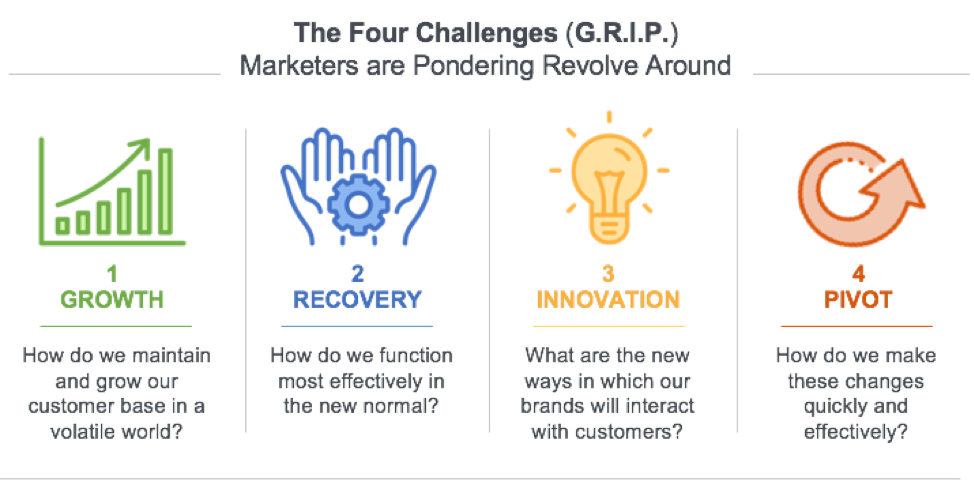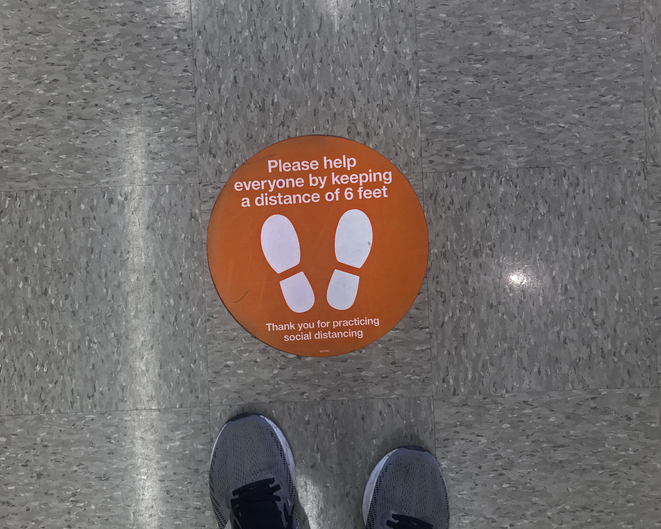The challenge: responding to crisis
Editor’s note: Roben Allong is CEO of Lightbeam Communications, New York. Allong can be reached at robena@lightbeamnyc.com. Jay Zaltzman is the president of Bureau West Market Research and Marketing Strategy, Los Angeles. Zaltzman can be reached at jay@bureauwest.com.
The authors would like to thank the following ThinkGlobal Qualitative team members for their contributions: Susan Abbott, Rebecca Bryant, Sofia Costa Alves, Véronique Gaboriau, Corette Haf, Darren Harvey, Jeff Hecker, Hana Klouckova, Ilka Kuhagen, Piyul Mukherjee, Astrid Velasquez and Rob Volpe
 Marketers around the world have been challenged to respond to two rapidly evolving crises at once: a pandemic affecting consumers, customers and clients, combined with a major economic slowdown caused by the pandemic response.
Marketers around the world have been challenged to respond to two rapidly evolving crises at once: a pandemic affecting consumers, customers and clients, combined with a major economic slowdown caused by the pandemic response.
ThinkGlobal Qualitative researchers conducted an extended online discussion with 35 marketing professionals in brand leadership and insights roles in large and medium-sized companies around the world over the course of 30 days in the first quarter of 2020 as the COVID-19 pandemic took hold. The goal of the research was to understand how marketers are handling the current crisis, what they consider best practices and their thoughts about how to move forward most effectively.

We were struck by how marketers around the world were facing similar challenges and generally agreed on the best approaches to address those challenges.
Our ThinkGlobal Qualitative members put their heads together with the marketers and developed potential solutions to address those challenges.
Growth: Re-envisioning disruption as a growth opportunity
The COVID pandemic caused profound disruption across the globe – and in the business world, for most marketers.
They are feeling:
- Unsure how to quickly determine how best to serve their customers.
- Uncertain how to communicate with their customers through this time of disruption.
- Challenged to make decisions moving forward when customers’ attitudes and needs seem to change weekly.
“Management want desperately to have a firm POV, and to make decisions now based on today's consumer behaviors. However, only some of the changed behaviors will be lasting. Not everything will stick. It's really challenging managing colleagues to refrain from making long-term projects from today. We've been recommending that we refrain from changing everything until we see the new normal.” [U.S.]
Marketers want to better understand their customers' whole ecosystem, so that they can continue to add value and act holistically.
- They recognize the need to formulate more empathetic relationships with customers; they want to obtain a better understanding of present values to get a more accurate directional picture instead of relying on past behaviors.
- Marketers require a flexible business mind-set in their organization in order to keep up-to-date on evolving consumer attitudes, pain points and opportunity gaps, and to strategize how to meet and harness these evolutions.
“Flexibility is going to be required in working with customers experiencing financial hardship. Large organizations typically are not well positioned for such flexibility and tailoring responses to individuals. That said, exhibiting empathy and flexibility during this crisis will yield huge future benefits.” [Canada]
Implications for your business
While customer attitudes are changing, smart marketers have an opportunity to uncover customers’ core values and use those as a basis for marketing communication.
This disruption has caused consumers to change their behavior and try new brands. Successful marketers are looking at ways to capitalize on the behavior change to bring in new customers, as well as remind existing customers of the reasons they love their brand. Companies can do this by returning to core values and being authentic with customers (more on authenticity below).
Recovery: How to function effectively in the new normal
Marketers realize that brands will need a more authentic connection with the people they serve, to attract new and keep existing customers. That means demonstrating
bonafide corporate social responsibility.
“Brands and what they truly embody will be even more important than ever before. There will be less tolerance for brands saying one thing and acting differently. If anything, people will choose the known and trusted in a world where so much is unknown and uncertain.” [Canada]
“Consumers will be seeking stability and reassurance. Brands that act responsibly (employee safety, social distancing, charitable donations and easier shopping experience) in an authentic way will be rewarded.” [U.S.]
Here is one example of a company taking steps in this direction: on May 20, Danone announced it will adopt a social and environmental purpose beyond profit as part of the company’s aim to get B Corporation certification by 2025.
In addition, marketers will need a deeper understanding of their customers – not as a monolithic “target market” but rather as individuals who are part of different cultures and sub-cultures.
Brands can do this by developing empathy. During the pandemic, marketers have experienced many of the same challenges facing their customers as they quickly had to adapt their homes to create e-work spaces and juggle work with the needs of their children, as well as concerns about their own health and financial security. Rediscovering that human element is key to developing empathy.
Marketers must then use that empathetic lens to really get to know their customers and what matters to them now. Surveys and big data are not enough; marketers will need to use qualitative research to have deeper conversations with their customers.
“[The biggest risk to my organization is] not asking customers, not listening, but thinking that we know them already. We might have known their needs prior to the crisis, they might have changed.” [Germany]
Implications for your business
At the beginning of the pandemic, customers focused on the lower levels of Maslow’s hierarchy of needs (food, safety). After a few months, there was a pent-up need to return to the higher levels (social connection, values). That was demonstrated by the strong and ongoing response to the killing of George Floyd in the United States that sparked social unrest and protests around the globe.
Customers are serious in their desire to see corporations demonstrate social responsibility. Marketers must uncover the values that are important to their customers and find ways in which their brands can support those values.
Organizations that develop a deeper understanding now will create new opportunities for competitive advantage as the marketplace continues to evolve through the waves of change caused by the pandemic.
Innovation: New ways to interact with customers
Marketers know things are changing – and that they will need to change accordingly – but they want to figure out which changes are temporary and which will be permanent, so they don’t over-react.
However, it now seems that even the “temporary normal” will be with us for quite a while; companies need to reassure customers that it is safe to do business with them. “Safety” means contactless interaction and sanitization protocols.
But it also extends to a more general feeling of reassurance to combat the confusion that has occurred as local and global economies reopen.
Another big change impacting brands: there is a significant segment of the population experiencing financial distress because of the pandemic. Marketers will need to consider ways to serve those customers, including discounts, payment plans and direct aid.
“We need to assist them to survive and cope with this. We are all in this together, so yes we need to keep the business running but we need to care more for our clients.” [South Africa]
“Greater social responsibility ... How will corporations solve the huge unemployment (22 million in U.S.) problem and deep financial crisis created by this pandemic. Most Americans cannot pay their bills or buy enough food.” [U.S.]
Implications for your business
It’s not enough to have a plan for how you run the business, that plan needs to be clearly communicated to customers. They need to feel that someone is in charge and that things are under control. Many airlines have been doing this, for example, by repeated in-flight announcements reassuring passengers about ventilation in the cabin and other safety measures.
Consider ways to offer lower-cost options to customers who are struggling without cannibalizing sales to those customers who can afford to spend money. This may be the time to introduce a “value” line or a discount program for those impacted by the pandemic.
Priorities in customer spending will continue to shift. Ongoing listening programs will help marketers understand and respond effectively.
Pivot: Making changes quickly
Marketers are concerned more than ever about becoming more agile. Fast, adaptive innovation and productivity are essential to maintain and grow profitability, in spite of market volatility, uncertainty, complexity and ambiguity. Businesses will need to move even faster to speed the innovation process and to generate solutions: research, develop, iterate, solve and repeat.
“Agile! It is more important ever before. I am still waiting five days for a research proposal from some agencies and project timing is about weeks. Results after a month means that I can do the same research again. And again and again. I need quick solutions.“ [Czech Rep.]
 Pivoting for marketers must now be fast and will take into consideration many market factors including technology acceleration, contactless interaction, rapidly changing brand landscape, start-up competition, available resources for business resiliency and sustainability, and of course the local economic climate.
Pivoting for marketers must now be fast and will take into consideration many market factors including technology acceleration, contactless interaction, rapidly changing brand landscape, start-up competition, available resources for business resiliency and sustainability, and of course the local economic climate.
At the same time, digitization can lead to brand trust erosion if the customer experience is perceived as impersonal. Marketers will have to look for ways to maintain customer engagement in a digital context.
Maintaining the brand experience through the pivot will be crucial. At a time when customer-facing employees of every organization are under tremendous pressure just to get their regular work done under new protocols, customer experiences cannot be allowed to deteriorate. Managing the experience so as to stay true to the brand ethos, continue building trust and engagement without losing core consumers will be challenging. Marketers will need to find ways to stay authentic and be transparent in their messaging to reassure their customers of their proven safety and quality.
“Those who communicate in an authentic, genuine, honest way, will have that loyalty repaid. Brands that find ways to offer their products or services with a balance of reassurance and moments of light relief.” [U.S.]
In addition, agility is required of marketers personally, as employees. They have had to embrace more technology and adapt to new work-from-home constraints including lack of in-person contact and relying solely on video conferencing to stimulate creative ways to solve problems and maintain productivity.
Implications for your business
Marketers must develop an agile strategy that allows for quick pivots. Developing a flexible, incremental action plan based on probabilities may be a way to embrace disruption with agility. Consider looking at three-month, six-month and one-year time horizons.
Companies will have to commit resources to plan for agility. Buy-in from the C-suite will be critical.
Now is the time to embrace online innovation and insights approaches. Online facilitation methods can be extremely effective in skilled hands, and will enable your teams to innovate without being together at an offsite.
The common themes: Deep understanding of customer
Gaining a deep understanding of your customers will enable you to get a G.R.I.P. and deal with all four challenges:

Qualitative research is best suited to gain this kind of deep understanding. It goes beyond surface answers and asks “why?”
It looks at both rational opinions and emotional reactions. That is the superpower of qualitative research: to take a mess of seemingly contradictory consumer input and distill it into actionable insight – to give marketers something that shines a light on what their brand needs to say, do and be.
We thank the marketers and brand leaders that took the time to share their insights with us and with each other in a pop-up global community. We hope they agree that we have distilled days of rich conversation into insights that bring clarity in a time of both challenge and opportunity.
